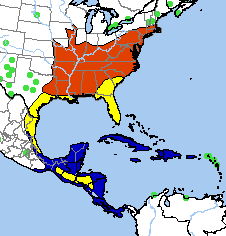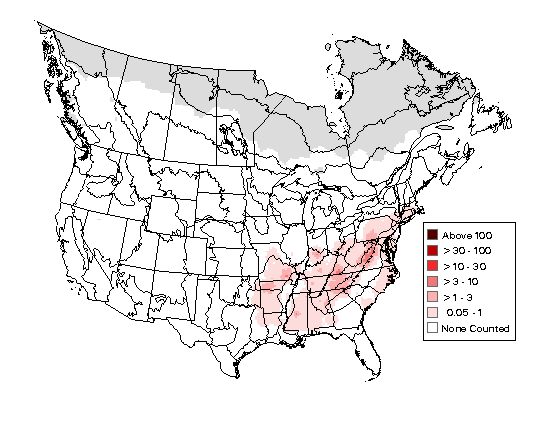Birdfinding.info ⇒ Generally uncommon except in prime breeding habitat in interior forests of the eastern U.S., mainly in hilly areas from the Ozarks to the central Appalachians (see Breeding Bird Survey Abundance Map in Notes below). Becomes briefly common in early to mid-April along the Gulf Coast of Texas.
Worm-eating Warbler
Helmitheros vermivorum
Breeds in the eastern U.S. Winters in Middle America and the West Indies.
Breeding. Mainly mature deciduous forests of the Appalachians, Ohio Valley, and Ozarks, from southern Wisconsin, New York, and Massachusetts south to eastern Texas and northern Florida.
Nonbreeding. Humid tropical forests from eastern Mexico to Panama, and in the Bahamas and Greater Antilles east to Puerto Rico.
Movements. Northbound migration is mainly late March to early May, through both Texas and Florida. Southbound migration is early, mainly August and September.
A regular spring vagrant in small numbers west and north of main breeding range, to Colorado, Minnesota, Ontario, and Nova Scotia. In fall, a fairly regular vagrant west to California.
Identification
Mostly olive overall, but buffy on the head and chest. Its most distinctive feature is four bold, black stripes on the head separated by three buffy stripes.
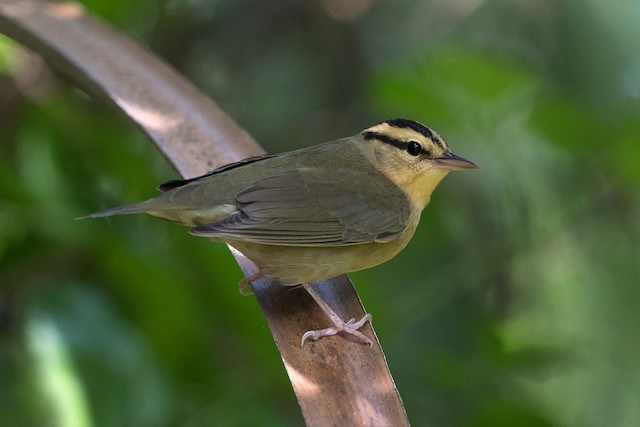
Worm-eating Warbler. (Fort De Soto Park, St. Petersburg, Florida; June 3, 2017.) © Peter Brannon

Worm-eating Warbler. (Galveston, Texas; March 28, 2016.) © Dennis Cooke

Worm-eating Warbler. (South Padre Island, Texas; April 9, 2018.) © Susan Strasevicz
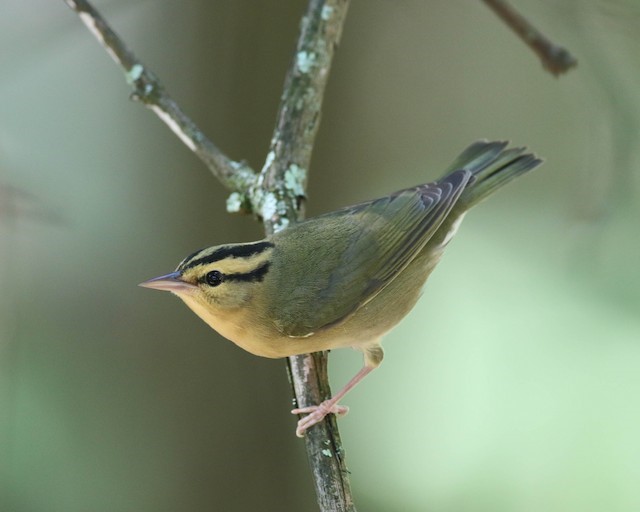
Worm-eating Warbler. (Kennesaw Mountain National Battlefield Park, Marietta, Georgia; August 16, 2017.) © Gene Koziara

Worm-eating Warbler. (Peveto Woods, Holly Beach, Louisiana; April 8, 2018.) © Charles Lyon
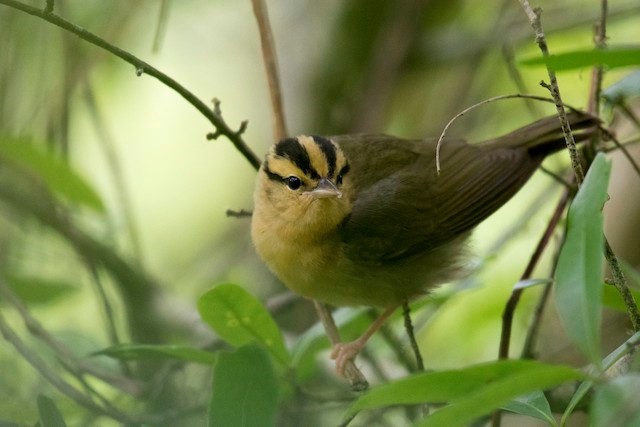
Worm-eating Warbler—note bold head pattern of four black stripes separated by three buffy stripes. (Peveto Woods, Holly Beach, Louisiana; April 8, 2018.) © Marky Mutchler
Cf. Black-eared Warbler. In Costa Rica and Panama, Worm-eating and Black-eared Warblers are easily confused, as they have approximately the same head pattern and overall coloration. Black-eared is less buffy than Worm-eating and shows a distinct blackish auricular mark.
Notes
Monotypic species.
References
Alderfer, J., and J.L. Dunn. 2014. National Geographic Complete Birds of North America (Second Edition). National Geographic Society, Washington, D.C.
Dunn, J.L., and K.L. Garrett. 1997. A Field Guide to Warblers of North America. Houghton Mifflin, Boston.
Fagan, J., and O. Komar. 2016. Peterson Field Guide to the Birds of Northern Central America. Houghton Mifflin Harcourt, New York.
Garrido, O.H, and A. Kirkconnell. 2000. Field Guide to the Birds of Cuba. Cornell University Press, Ithaca, N.Y.
Garrigues, R., and R. Dean. 2014. The Birds of Costa Rica: A Field Guide (Second Edition). Cornell University Press, Ithaca, N.Y.
Haynes-Sutton, A., A. Downer, R. Sutton, and Y.-J. Rey-Millet. 2009. A Photographic Guide to the Birds of Jamaica. Princeton University Press, Princeton, N.J.
Howell, S.N.G., and S. Webb. 1995. A Guide to the Birds of Mexico and Northern Central America. Oxford University Press, Oxford.
Latta, S., C. Rimmer, A. Keith, J. Wiley, H. Raffaele, K. McFarland, and E. Fernandez. 2006. Birds of the Dominican Republic and Haiti. Princeton University Press, Princeton, N.J.
Raffaele, H. 1989. A Guide to the Birds of Puerto Rico and the Virgin Islands. Princeton University Press, Princeton, N.J.
Raffaele, H., J. Wiley, O. Garrido, A. Keith, and J. Raffaele. 1998. A Guide to the Birds of the West Indies. Princeton University Press, Princeton, N.J.
Ridgely, R.S., and J.A. Gwynne. 1989. A Guide to the Birds of Panama (Second Edition). Princeton University Press, Princeton, N.J.

